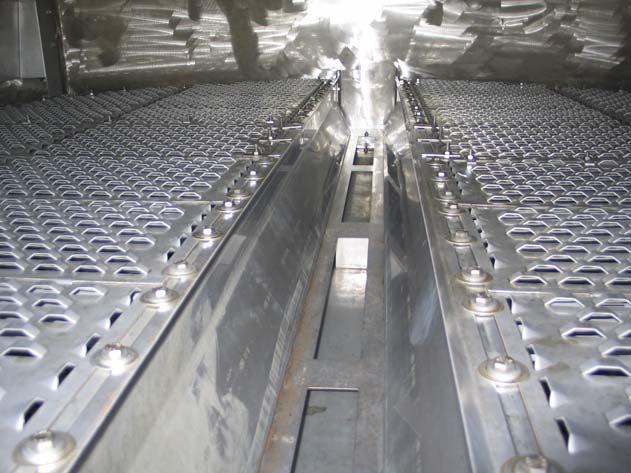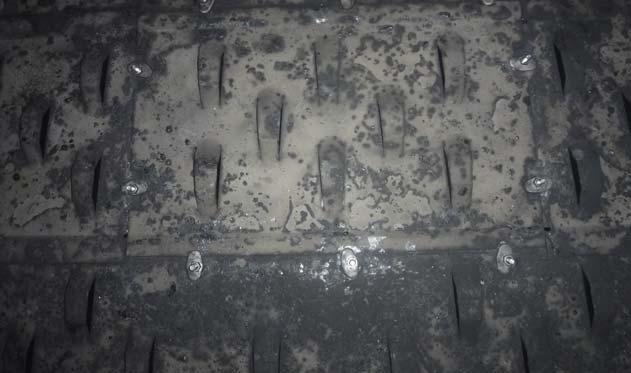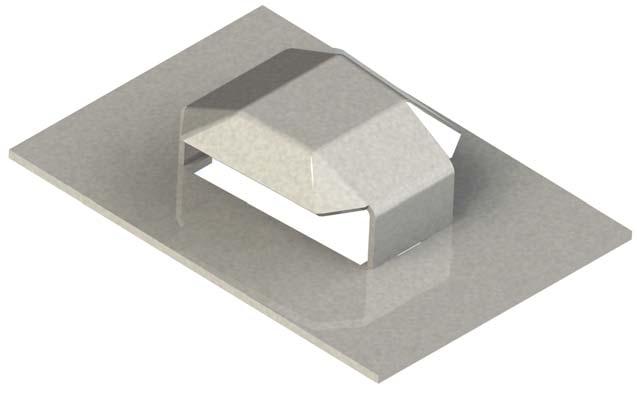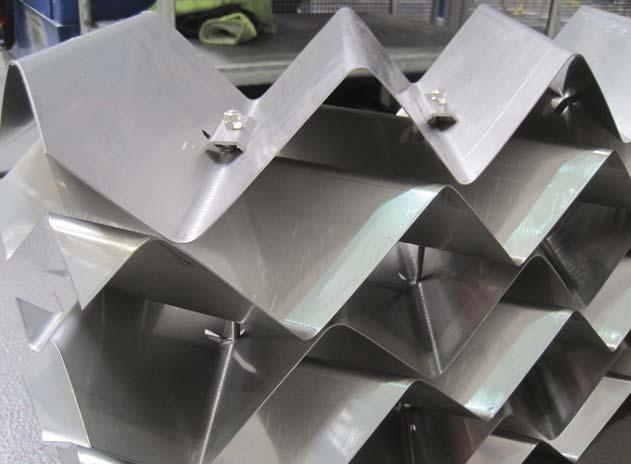
11 minute read
Advanced column internals for fouling towers




Ang Chew Peng and Lee Siang Hua, Sulzer Chemtech, Singapore, consider high-performance anti-fouling trays and packing that can help to minimise the accumulation of foulants in towers.



Distillation and absorption are essential mass transfer processes in refi ning, petrochemical and chemical processing plants. These towers are usually equipped with internals such as trays, structured packing or rings, as well as associated feed distributors and collectors.
Some of these towers, in certain services or applications, are prone to fouling. Over time, this accumulation of foulants will eventually plug the column internals, adversely affecting the hydraulic and separation performance of these towers. It is in the producers’ economical interest to operate the plant as long as possible before having to shut down the towers for cleaning.
There are several methods to mitigate fouling, depending on the type of foulants and their mechanism of formation. In recent years, Sulzer has developed robust, high capacity mass transfer components featuring anti-fouling designs that minimise the accumulation of foulants for a longer run length between turnarounds. This article will discuss some high-performance anti-fouling trays and packing that have been developed for these fouling and often heavy-duty services, as well as their successful applications.

Fouling mechanism and overview of mitigation
In the wide range of process operations, there is a tremendous variation in the fouling tendencies of the process fl uids and associated equipment metallurgy. Fouling is generally referred to as “solids inhibiting the fl ow of vapour and/or liquid on the trays or packing”. These solids can be particles, polymers or corrosion products and have different textures ranging from powdery to sticky. The main fouling mechanisms commonly observed in the industry include: Deposition of solids such as corrosion products, catalyst particles. Solid precipitation leading to formation of carbonates and chloride salts. Chemical reactions such as polymerisation and coke formation. Figure 1 shows the wash bed of the coker main fractionator after three years of operation.
The fi rst step in dealing with fouling is to identify the fouling components and the mechanism of formation. As per

literature, if the foulants are introduced into the towers, the most effective method to keep these fouling materials out of the towers is with fi ltration.1 Some foulants that have developed inside the towers are caused by reaction or degradation of process fl uids. It is possible to mitigate the fouling if the operating temperature is controlled at the level where these reactions or degradation cannot take place. Adjustment of column temperature often involves the control of operating pressure. For instance, the refi nery vacuum distillation unit (VDU) is operating at high vacuum to avoid cracking of the heavier hydrocarbons, producing coke particles which will plug the column internals. Using process control to manage fouling can be costly as it deviates from the optimal operating points, which produce the most product at the lowest energy input.
In certain applications such as olefi ns production, anti-foulants have proved to be effective in inhibiting polymerisation. However, the use of anti-foulants may not be the solution for all fouling services. In towers where the various methods (such as fi ltration, process control and anti-foulants) cannot effectively mitigate fouling, producers and operators turn to mechanical solutions – the use of advanced column internals specially designed to handle the fouling conditions, prolonging the run length between turnarounds.

Figure 1. Coke formation in the coker wash bed after three years of operation.
Figure 2. Sulzer VG AF™ anti-fouling trays with SVG™, push valves and enhanced outlet weirs.

Fouling resistant trays
Most of the towers that handle dirty or heavy process fl uids are equipped with trays, unless there are temperature or pressure drop requirements which favour the use of packing. Trays have a relatively open structure and are less prone to plugging compared to the denser packing. In towers that process very heavy feeds and have lower demand on separation performance, baffl e trays are often applied. There are various types of baffl e trays, including segmental baffl es, disc and donut and showerdeck trays. These baffl e trays are segmented plates that allow the liquid to descend from baffl e to baffl e while the vapour passes through the liquid curtain formed between the baffl es. These baffl es can be sloped, to minimise the accumulation of solids on the decks. In general, baffl e trays have lower effi ciencies compared to cross-fl ow trays due to the substantially reduced vapour-liquid contact.
For distillation towers that have stringent requirements for product purities, adequate vapour-liquid mixing on the tray deck is essential for separation performance. If the fouling is not severe, specially designed cross-fl ow trays can be applied. Certain zones on the trays are more susceptible to the settlement of foulants, such as the area behind the downcomers and outlet weirs, as well as on the stagnation zones where liquid fl ow is slower. A good ‘anti-fouling’ tray design centres around the techniques to mitigate the fouling for each of these problem areas: Enhanced outlet weirs to minimise accumulation of solids. Push valves to promote the flow of liquid, to avoid stagnation zones. Sloped downcomers for a higher downcomer bottom velocity to flush the solids.
Foulants can also plug the tray decks over time, so the selection of the appropriate perforation is very important. It is widely known in the industry that movable valves are not recommended for dirty services as the valve legs may become stuck due to foulants, restricting their ability to open fully. In most fouling services, large fi xed valves are applied, with the selection of the perforation size depending on the type and size of the fouling particles. Figure 2 shows Sulzer VG AFTM anti-fouling trays with large SVGTM fi xed valves, and enhanced features to minimise fouling on the tray decks. The largest, most fouling resistant, fi xed valve in the Sulzer portfolio is the XVGTM , which has been successfully applied in numerous applications including towers processing bitumen with sand. Figure 3 shows these XVG trays after three years of operation in this service.
The vapour handling capacity of large valves can be a concern, as they are often associated with lower capacity as compared to smaller valves. As producers ramp up production throughput, there is a demand for high capacity anti-fouling valves for heavy-duty services. As such, Sulzer developed the UFMTM AF, a large fi xed valve with excellent vapour handling capacity comparable to mini valves, as shown in Figure 4. The signature domed shaped cover directs vapour downwards towards the tray deck, thereby reducing the overall froth height, and increases vapour-liquid mixing on the deck. When tested in a 1 m test column with a chlorobenzene/ethylbenzene test system, UFM AF displayed 10% higher useful capacity than conventional fi xed valves while maintaining high effi ciency, as shown in Figure 5. UFM AF has been successfully applied in
heavy duty services including refi nery main fractionators, beer towers and beer strippers, improving their run length while meeting the high capacity demands. A recent revamp of the stripping section of a crude tower, from seven conventional trays to nine UFM AF trays, brought about an increase in recovery of diesel, even when the tray spacing was reduced by 20%.
Fouling resistant structured packing
For some towers, it is essential to keep the overall column pressure drop as low as practically possible to maintain a low column bottom temperature and, in some cases, to decrease the compression ratio of downstream compressor. Structured packing is usually the preferred choice of mass transfer internals for these towers, as pressure drop across packed columns is fi ve to ten times less than trayed columns. The typical examples are the VDU and FCC main fractionator in oil refi neries as well as primary fractionator and water quench towers in naphtha cracker complexes. To fulfi ll the low pressure drop requirement and maintain the high resistance to fouling, anti-fouling structured packing has been developed. These heavy-duty packings, formed by corrugated metal sheets, include the following features: Large crimp height. Moderate to low surface area (between 40 – 90 m2/m3). Smooth surface without grooving or orifices. Thicker metal sheets (at least 0.5 mm thick). Shorter element height.
The thicker metal sheets with shorter element height improves the robustness of the packing and the ease of cleaning. The large packing void and smooth surface make the packing less susceptible to the deposition of foulants. Figure 6 shows a Sulzer anti-fouling packing, MellagridTM AF.
With the corrugated metal sheets within the packing being held together by tie-rods, there are contact points between the peaks of the crimps of adjacent metal sheets. Experiments have shown that these contact points are essential for a proper spread of liquid to fully wet the metal packing surface. This distribution of liquid is not only critical to mass transfer, it also minimises the risk of coke formation through reduced dry spots. Though spacers could eliminate the contact between corrugated metal sheets, this will adversely lead to uneven liquid distribution, aggravating the fouling issue. There are other inevitable contact points between the packing and other surfaces such as column wall, support beams and distributors, and Sulzer has engineered solutions to mitigate fouling at these zones.
Deposition of solids may also occur between the packing elements. The change in vapour fl ow direction as liquid descends from one element to another results in a higher liquid holdup at the transition. Compared to denser structured packing, anti-fouling packing with larger void allows for lower pressure drop and holdup between the packing layers, which reduces the risk of coke formation.
Liquid distributors are the heart of the packed columns; anti-fouling structured packing cannot work well without a well-designed liquid distributor. Liquid distributors specially designed for dirty services usually have large orifi ces on both sides of the liquid arm channels. Lateral liquid discharge uses orifi ces raised above fl oor level (away from heavy fouling materials that may accumulate on the fl oor) to minimise the potential plugging of the holes. Overfl ow notches could be added on the upper edges of the liquid channels to allow liquid to overfl ow in a controlled manner, in the undesired circumstance that the primary orifi ces are plugged over long periods of operation.
The following case study illustrates how fouling leads to premature fl ooding of the packed columns, and it was successfully debottlenecked with the use of advanced column internals. In 2014, a FCC main fractionator in an Asian refi nery,

Figure 3. Sulzer XVG™ trays, in tower processing bitumen with sand, after three years of operation.

Figure 4. Sulzer UFM™ AF fixed valve.

Figure 5. The capacity enhancement of UFM™ AF over conventional fixed valve

Figure 6. Sulzer anti-fouling Mellagrid™ AF.
equipped with six structured packing beds and two trayed sections, was only able to operate at 85% of the design loads. Process simulation and hydraulic evaluation indicated that the tower was not at hydraulic limits. The study of the column pressure drop profi le revealed that the actual pressure drop across the bottom three beds was much higher than predicted by the hydraulic tool. Further investigation suggested that the cause of poor tower performance was the accumulation of foulants in the packing from the catalyst carryover. In the following year, the packing in the bottom slurry pump around bed, wash bed and heavy cycle oil (HCO) pump around bed were replaced with Sulzer anti-fouling packing Mellagrid with customised liquid distributors. Since the revamp in 2015, this FCC main fractionator has been operating successfully without any hydraulic constraint. It is able to handle an additional 10% higher capacity above the revamp loadings, with products well within specifi cations. The observed pressure drop is also lower than predicted.
Conclusion
Fouling in distillation towers can be a costly problem as it prematurely limits the hydraulic capacity, affects the product specifi cations, and requires regular cleaning. This article discussed the techniques used to mitigate fouling by mechanical methods. For trayed columns, the combination of large fi xed valves with advanced tray design features provide a robust solution for fouling applications. The development of high capacity anti-fouling valves allows these towers to handle higher throughput while maintaining good mass transfer effi ciency. In heavy-duty packed columns, the use of Mellagrid AF – the large void structured packing with smooth surfaces – minimises fouling tendency. Carefully designed liquid distributors ensure that the liquid distribution is not adversely affected in these packed columns processing heavy fl uids. These advanced engineered solutions have successfully proven to minimise the accumulation of foulants on the mass transfer equipment, thereby extending the tower’s run length between turnarounds and offering economic benefi ts to producers.
Reference
1. PILLING, M., ‘Dealing with column fouling,’ PTQ, (Q1 2016).


AntiMercure® Systems
• Proven 99% mercury removal from water • Continuous operation • Easy installation and start-up • Pre-engineered, skid mounted – 3 standard sizes










